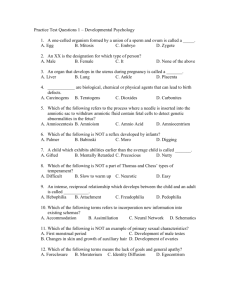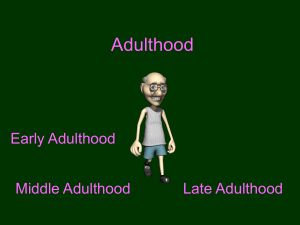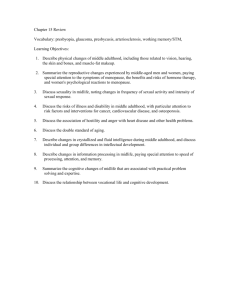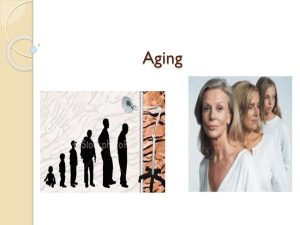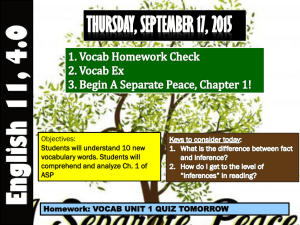Lecture 10 LATE ADULTHOOD
advertisement
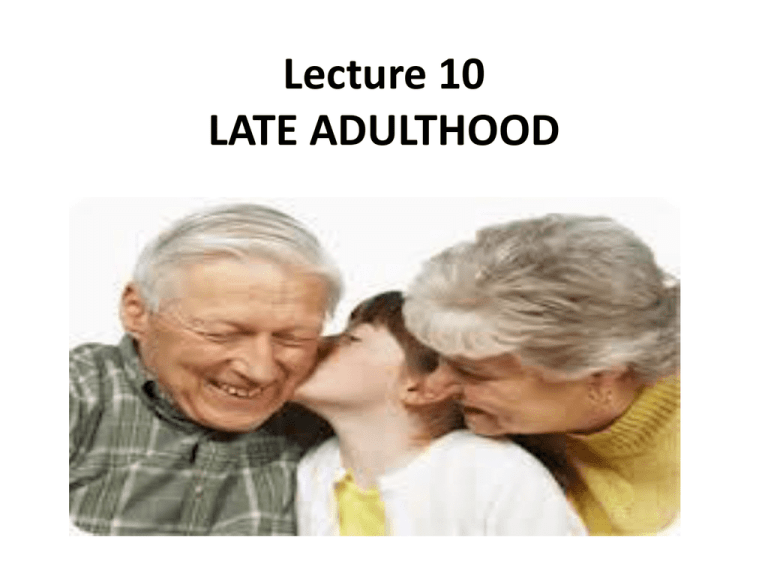
Lecture 10 LATE ADULTHOOD OBJECTIVES: After the completion of this chapter, the student will be able to: • Define late adulthood. • Identify common health concerns of late adulthood. • Describe challenges and developmental tasks of late adulthood • Discuss lifestyle changes that may be necessary for late adulthood. • Define elder abuse and state on way it can be prevented. • List the learning needs of later adulthood. • Select appropriate teaching techniques to promote effective care Definition • The U.S government defines old age as over age 65 when full security benefits become available, retirement usually occurs, And a leisurely lifestyle is assumed. Late adulthood is considered to encompass the ages between 65 and 74 years. The comment health risks and leading causes of death the older adult include: 1- cancer. 2- heart disease. 3- stroke. 4- pneumonia. 5- influenza. These risks can decrease through preventative treatment, social support, and healthy behaviors. measures, medical Some health concerns of the older adult include following • Development of osteoporosis • Risks for falls and fractures • Poor awareness of healthy behavior options • Increased risk of influenza and pneumonia • Development of cataract. • Compensation for developing hearing defects. • CHALLENGES • Access to health • Reduced income – Reduced income is a problem for many older adults. Social security and pension incomes may not cover daily ling and health care expenses • Changes in Living Arrangements adjusting to changes in living Arrangements can also influence the physical and mental well – being of the older adult . • Cost of health care – private Insurance and Medicare cover some of the clinic or office care but the focus is often on treatment • Altered Nutritional Needs – Dental problems , inability to cook dislike of eating alone plan or malaise due to a medcal condition or lack of accommodation for special needs related to cultural or religious. • Assistive Devices. • Preventing Falls. • Polypharmcy – the problem of polyphamacy with the use of medications by older adults Polypharmcy Task and challenges of the older Adult o o o o o o o Older adults must adjust to the following Menopause Retirement and redirection of goals and energy Decreased income Grandparentig Reentry into the job market Maintaining access to health care GRANDPRENTING • When healthy older adults assume the role of Grandparents they often do more for their children than their children do for therm. • Nurses and heath care workers can educate and guide families concerning resource available to them before emotional stress strain caregiver burnout, and older adult alienation occur. Elder or Dependent Abuse: Elder abuse is defined as infliction of harm or neglect through actions or acts of omission. Abuse can be: • physical • emotional • financial • can include neglect or personal rights. The family or health care worker can observe interactions between older adults and the caregivers alert other family members to potentially abusive situations. POSTMENOPAUSAL CARE • Adjusting to the postmenopausal phase of life in as important task of the older woman Menopause in defined as the absence of menstruation for a period of at least I year due to decline or cessation of hormonal production and function. • Menopause is not a disease or illness it is a natural occurrence in the life cycle there are discomforts and risks associated with the postmenopausal phase that can be averted with heath lifestyles and access to preventative medical care same dis- comforts associated with post menopause include genital atrophy, vasomotor instability heart disease, breast cancer, or osteoporosis, hormone replacement therapy (HRT). • Complementary and alternative medical therapies (CAM) are also available when HRT is not recommended. HEALTH SCREENNGS Health screening can identity developing heath issues in early stages and can lead to early interventions and prevention of greater difficulties, screenings should include: • Dental and eye checkups. • Physical evaluation includes weight blood pressure, thyroid and blood glucose and lipid levels. Postmenopausal bone loss and osteoporosis should be assessed regularly and preventive measures such as: - Increased calcium intake, vitamin D. - And daily weight – bearing exercise can be emphasized dung routine office visits. • MEMORY • The older adult experiences memory changes, particularly in remembering names and faces of people Normal memory loss can be associated with aging and temporary memory loss can be due to depression or anxiety preclinical manifestations of Alzheimer's disease are a common worry when normal memory loss becomes noticeable. Warning signs of problematic Memory Decline: Memory loss affecting job functioning Difficulty remembering steps in familiar tasks Disorientation Lack of awareness of time, place , or date Decrease in abstract thinking (increased need for concreteness) Associated problems mood, language, or personality changes PSYCHOSOCIAL ISSUES FOR THE OLDER ADULT The social network of friends usually narrows for the adult due or the death or peers. Remaining an integral part of an extended family provides valuable social activity and relationships but they may be different then peer relationships. • DEPRESSION IN THE OLDER ADULT: • A young person who looks at life's events in a pessimistic way may be vulnerable to developing depression as an older adult. TEACHING TECHNIQUES AND GOALS FOR THE OLDER ADULT: • Scheduling short teaching sessions enables the older adult to concentrate and adsorb all the information throughout the session without losing concentration due to fatigue or other interference. • Relating learning topics to autonomy , social acceptability and strong coping skills can best effectiveness of learning.
